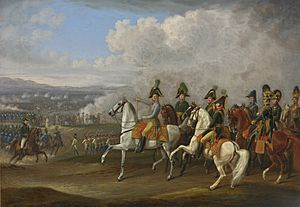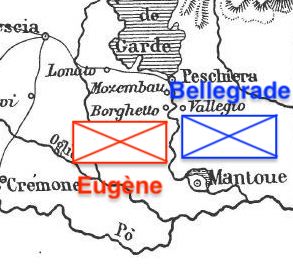Battle of the Mincio River (1814) facts for kids
Quick facts for kids Battle of the Mincio River |
|||||||
|---|---|---|---|---|---|---|---|
| Part of the War of the Sixth Coalition | |||||||
 Field Marshal Heinrich von Bellegarde and his staff at the battle of the Mincio River, by Albrecht Adam. |
|||||||
|
|||||||
| Belligerents | |||||||
|
|||||||
| Commanders and leaders | |||||||
| Strength | |||||||
| 34,000 | 32,000–35,000 | ||||||
| Casualties and losses | |||||||
| 3,500 dead and wounded | 4,000 dead, wounded, and captured | ||||||
The Battle of the Mincio River happened on February 8, 1814. It was part of the War of the Sixth Coalition, a big conflict in Europe. This battle was fought between the French army, led by Eugène de Beauharnais, and the Austrian army, led by Field Marshal Heinrich von Bellegarde.
The battle took place near the Mincio River in what is now Italy. It ended with no clear winner. Even though Napoleon had won a big victory in the same area years before, this battle didn't change the overall war much. The main decisions of the war were happening in France, not Italy.
Contents
Why the Battle Happened
After Napoleon lost a major battle in 1813, his French armies had to retreat. They were trying to protect the French Empire from the Allied forces. But the war wasn't just in France. The Austrians wanted to take back Northern Italy.
Murat, the King of Naples, had joined the Allied side. This meant he was now a threat to Eugène's French army. An Austrian army under Bellegarde was also moving in from the east. Eugène felt he had to fight one enemy before dealing with the other. Since the Austrians were closer, Eugène decided to fight them at the Mincio river.
Getting Ready for Battle
The battlefield was a long, narrow area, about 20 miles long. It stretched from Lake Garda in the north down to the fortress of Mantua in the south. With about 70,000 soldiers spread out, it was hard for commanders to know what was happening. This made it difficult to react quickly. The Mincio River had many villages and bridges, which became important fighting spots.
Eugène had about 41,000 soldiers. But he sent 7,000 to guard his southern side near the Po River. This left him with 34,000 men for the battle. His army included Italian Royal Guards, cavalry, and two smaller groups of soldiers. These groups were led by generals Paul Grenier and Jean-Antoine Verdier. Grenier's troops were near Mantua, and Verdier's were at Peschiera in the north.
Eugène planned to attack from both sides, hoping to trap the Austrians. This kind of plan usually needs many more soldiers or very fast movement. The French didn't have either of these advantages.
Bellegarde had about 35,000 soldiers, similar to Eugène's numbers. He placed his troops to watch Peschiera and Mantua, which the French controlled. He also had enough soldiers to attack the French in the middle, near Borghetto. Bellegarde thought the French would retreat. But when his patrols saw many French soldiers, he changed his mind. He decided not to send all his troops forward. He kept some soldiers in reserve, which helped his army later.
Neither side knew what the other was planning. Bellegarde expected Eugène to retreat, and Eugène didn't expect Bellegarde to attack. So, when the fighting started, both commanders were surprised by what happened.
The Battle Begins
The battle started around 8 AM on February 8. Austrian soldiers began to arrive at Borghetto without any fighting. The French had left their positions in the middle of the night. This made the Austrians think the French were indeed retreating. The Austrians moved northwest and met some French soldiers near Olfino. General Verdier realized his troops were cut off from the main French army. So, he stopped his attack plan. He ordered some Italian soldiers back to Peschiera and told another group to face south.
More and more Austrian troops crossed the river. But while the French were struggling in the middle, their attack in the south was going well. About 20,000 French soldiers were part of this attack. They attacked from Mantua and from the village of Goito. General Bonnemains led the first group of Eugène's attack. They easily defeated the Austrian outposts, taking over 500 prisoners. Eugène and Grenier's forces then met up at Roverbella.
The French kept pushing north. Around 10 AM, Eugène heard gunshots from the west side of the river. He was shocked to see a large part of the Austrian army where he didn't expect them.
Turning Points
At this point, the armies were in strange positions. Many soldiers were on the side of the river where their enemy had started. Eugène made a smart decision: he kept attacking. He hoped his advancing troops would scare the main Austrian army back across the Mincio River. He sent some Italian Royal Guards back to Goito to protect a bridge. He also strengthened his eastern side against the Austrians. With 13,000 men and 30 cannons, he moved north to Valeggio. He wanted to cut off the Austrian retreat.
Bellegarde's earlier decision to keep soldiers in reserve now paid off. These reserve soldiers fought back against the French. They even captured some French cannons, though the French later got most of them back. Eugène's men attacked the Austrian reserve. The Austrians fought bravely, losing many men, but they stopped the French from breaking through.
Realizing the danger, the Austrian reserve commander pulled his men back. Eugène's men attacked again, but by then, more Austrian soldiers had arrived. This stopped the French attack. The fighting continued until nightfall, preventing the French from capturing a key bridge. Meanwhile, in the north, the French soldiers had been barely holding on. But when they heard Eugène's cannons, they fought harder and defeated the Austrian attacks.
Bellegarde thought Eugène would keep attacking in the morning. So, he ordered his army to retreat across the river. But again, Bellegarde was wrong. Eugène wanted to connect with his northern forces. He quickly pulled his troops back to where they had started, Goito and Mantua.
After the Battle
Eugène told his wife that he had won the battle. But in truth, it was a messy fight with no clear winner. The number of soldiers lost was not very high. The French lost about 3,500 men, and the Austrians lost about 4,000.
Even though it wasn't a big victory, Eugène showed he was a strong and skilled commander. He continued to fight well throughout the rest of the campaign. He kept fighting until Napoleon gave up his power in April.
Images for kids



